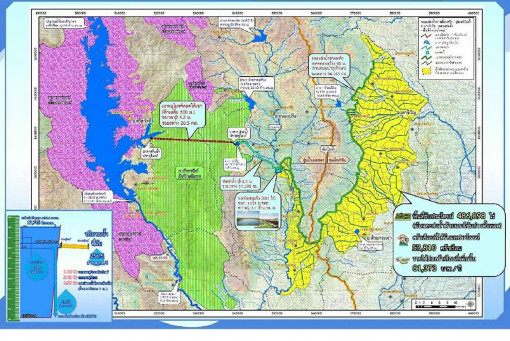Study favours Kanchanaburi project

A water diversion tunnel project will help relieve drought issues in the five districts of Kanchanaburi, with a study showing the tunnel construction will not harm wild animals or the ground surface.
The 12-billion-baht project aims to divert 378 million cubic metres (m³) of water from Srinagarind Dam, the largest dam in the western region, to a 200,000-rai area in Kanchanaburi’s districts of Huay Krachao, Lao Khwan, Bo Phloi, Nong Prue and Phanom Thuan.
The project aims to mitigate a water shortage in the five drought-stricken districts located in rain shadow areas.
Chaitas Imsamranrat, a representative of the project’s advisory team, yesterday said the Office of the National Water Resources (ONWR) finished the project’s feasibility study in five districts in April 2021.
The tunnel, which will be 20.5km long and 4.2m wide, is divided into four phases.
First, water will be diverted under the mountain, at an average depth of 500m below the surface, to Lam E Su reservoir, with a diversion rate of 1.03 million m³ of water per day. Water-receiving and discharging buildings will also be built with a budget of 4.28 billion baht.
A new transportation system will then be installed to take water to a clarifier site with a budget of 3.12 billion baht, before constructing a 3-billion-baht Lumrang clarifier site.
Another water transport system will be constructed to discharge water into a main concrete canal and its 42 sub-routes for public use with a budget of 3.99 billion baht.
However, some agencies are concerned about the project’s environmental impact as the first phase of the construction is located in the Salakpra Wildlife Sanctuary.
Mr Chaitas, the Office of the National Water Resources representative, recently gave his office’s assurances over the project’s environmental safety.
He said the project’s excavation process will use a tunnel boring machine (TBM), which is considered the most efficient method for long tunnels, with higher productivity and a safer work environment.
The project is designed to simultaneously excavate the mouth and the end of the tunnel, each side stretching about 10km, to mitigate noise pollution and other negative impacts in the area, Mr Chaitas said.
During tunnel excavation, the drilling and blasting process will be carried out around the mouth of the tunnel to prepare for the tunnel boring machine on the main tunnel.
Each blast can take out four to six metres of space per day, and may take about three months to reach 50m.
The drill bit used for the TBM process is about 4m in diameter, with the capacity to drill about 12–20m per day or about 10 kilometres on each side. It might take four years to finish, Mr Chaitas said.
The project is also backed by Sakda Wichiansilp, Pheu Thai MP for Kanchanaburi and chairman of a House committee studying drought solutions to the El Niño weather phenomenon, who urged government agencies to speed up the construction process.
Mr Sakda has urged agencies to raise awareness of the importance of the project to alleviate the drought issues among locals.

